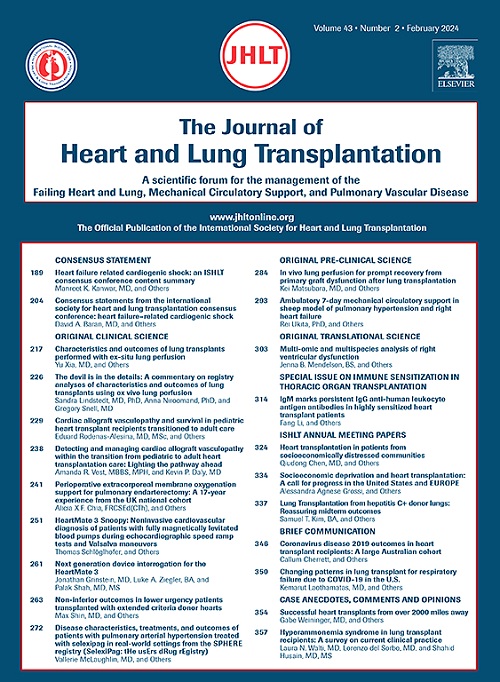目测冠状动脉钙在心脏移植受者中的附加预后价值。
IF 6.4
1区 医学
Q1 CARDIAC & CARDIOVASCULAR SYSTEMS
引用次数: 0
摘要
背景:心脏杂交正电子发射断层扫描/计算机断层扫描(PET/CT)已成为高密度超声心动图术后心脏同种移植血管病变(CAV)的有效筛查方式。可视估计冠状动脉钙化(VECAC)可从作为 PET/CT 一部分获得的 CT 图像中量化,已被证明与冠状动脉疾病的不良心血管预后相关。我们研究了心脏移植(HT)后 VECAC 的预后价值:我们对 2016-2019 年间接受 13N-氨心脏 PET/CT 检查并随访至 2022 年 10 月 15 日的 430 例连续成人 HT 患者进行了回顾性分析。VECAC 类别包括VECAC 0、VECAC 1-9、VECAC 10-99和VECAC 100+。采用单变量和多变量比例危险回归评估了 VECAC 类别与结果之间的关联。主要结果是死亡/移植:结果:73%的患者为男性,33%患有糖尿病,67%具有估计肾小球滤过率:结论:VECAC 是 HT 后死亡/移植后再植的独立预后指标,值得作为 HT 后监测 PET/CT 的一部分。本文章由计算机程序翻译,如有差异,请以英文原文为准。
Added prognostic value of visually estimated coronary artery calcium among heart transplant recipients
Background
Cardiac hybrid positron emission tomography/computed tomography (PET/CT) has become a valid screening modality for cardiac allograft vasculopathy (CAV) following heart transplantation (HT). Visually estimated coronary artery calcium (VECAC) can be quantified from CT images obtained as part of PET/CT and has been shown to be associated with adverse cardiovascular outcomes in coronary artery disease. We investigated the prognostic value of VECAC following HT.
Methods
A retrospective analysis of 430 consecutive adult HT patients who underwent 13N-ammonia cardiac PET/CT from 2016 to 2019 with follow-up through October 15, 2022, was performed. VECAC categories included: VECAC 0, VECAC 1–9, VECAC 10–99, and VECAC 100+. The association between VECAC categories and outcomes was assessed using univariable and multivariable proportional hazards regression. The primary outcome was death/retransplantation.
Results
The cohort was 73% male, 33% had diabetes, 67% had estimated glomerular filtration rate <60 ml/min, median age was 61 years, and median time since HT was 7.5 years. VECAC alone was insufficiently sensitive to screen for CAV. During a median follow-up of 4.2 years ninety patients experienced death or retransplantation. Compared with those with VECAC 0, patients VECAC 10–99 (HR 2.25, 95% CI 1.23–4.14, p = 0.009) and VECAC 100+ (HR 3.42, 95% CI 1.96–5.99, p < 0.001) experienced an increased risk of death/retransplantation. The association was similar for cardiovascular death and cardiovascular hospitalization. After adjusting for other predictors of death/retransplantation, VECAC 10–99 (VECAC 10–99: aHR 1.95, 95% CI 1.03–3.71 p = 0.04) and VECAC 100+ (VECAC 100+: aHR 2.33, 95% CI 1.17–4.63, p = 0.02) remained independently associated with death/retransplantation.
Conclusions
VECAC is an independent prognostic marker of death/retransplantation following HT and merits inclusion as a part of post-HT surveillance PET/CT.
求助全文
通过发布文献求助,成功后即可免费获取论文全文。
去求助
来源期刊
CiteScore
10.10
自引率
6.70%
发文量
1667
审稿时长
69 days
期刊介绍:
The Journal of Heart and Lung Transplantation, the official publication of the International Society for Heart and Lung Transplantation, brings readers essential scholarly and timely information in the field of cardio-pulmonary transplantation, mechanical and biological support of the failing heart, advanced lung disease (including pulmonary vascular disease) and cell replacement therapy. Importantly, the journal also serves as a medium of communication of pre-clinical sciences in all these rapidly expanding areas.

 求助内容:
求助内容: 应助结果提醒方式:
应助结果提醒方式:


